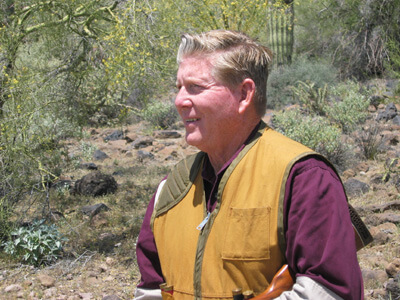Western Outdoor Times
Jerry Tate Spring Time On Desert Lakes
The Symphony Of Nature
Springtime On Desert Lakes
Second In The Series By Jerry Tate, JT s Guide Service
Because of the increase in Arizona s population and the need for water, the dams that were constructed to control water here in Arizona not only contained the water, but also created an explosion of wildlife.
The new waterways created an abundance of indigenous plants and animal life, which include non-indigenous plants brought in by settlers and that now exist in the desert.
Today we know that people unknowingly are transferring aquatic life from one body of water to another without knowing the consequences and the devastation they are creating. Along with the reservoirs came the migration of animals and birds that created so much more for us to observe and learn from.
 Photo
Credit Stephanie Tate
Photo
Credit Stephanie Tate
Who would have thought they would see a loon at the desert lakes or a blue heron on the shores, as well as egrets, seagulls, pelicans, and various fish-eating water fowl?
The blue heron as an example: Not only does it eat fish but also lizards, snakes and any other desert creatures that it can swallow. The blue heron does not pick its pray apart like the eagle and hawk, but swallows it whole.
Watching the blue heron hypnotize a lizard by using the lower neck feathers and by moving the neck itself back and forth but keeping the head perfectly still, striking at lightening speed as it captures its pray to feed itself or its offspring is an amazing sight; things like this to an outdoorsman comprise the ultimate experience watching nature in perfection.
The release of the domestic burro (donkey) from early minors and settlers created perhaps not directly through releasing but by the burro s escaping from captivity adds to the wildlife for people to enjoy and observe. Watching the habit of the herd, as well as watching the pecking order earned by the dominate one is incredible as with all wildlife.
One example is the birth of the colt and the precise location chosen by the Jenny (female burro) to give birth. This particular place is usually a large flat rock washed clean by the rains of the desert. This place is usually near water because the Jenny needs to re-hydrate herself after giving birth; she is weak and can not travel far.
The Jenny will get the colt up as soon as possible and help it become sure footed in a very short period of time; she never leaves the colt behind when feeding or going to water. With the rest of the herd present, a mountain lion or any other predator does not have much of a chance to get to the unsuspecting colt. The other Jennys of the herd offer protection of the young from birth until they are close to one year old.
As you can see by watching wildlife above the water, it can be hints to the aquatic wildlife and their habits of migration. In this computerized age, you can choose a specific species and get into every detail of their behavior.
Their body functions are what drive them into certain locations on a body of water just one aspect of learning about the species. Learning about the species includes the behavior created by nature and by man: by nature, water current, wind, sun penetration, clarity of water, etc.
Man-made influences include all watercraft and every noise that is transferred into the water through the boat hull, the engine, banging in the boat, various vibrations caused by mechanical parts, etc.
With this type of detail, you can also zoom into their seasonal patterns. By studying a specific aquatic species that you would like to harvest can cut down on search time. You need to locate the fish before you can catch them, just as you need to scout for big game before you can harvest them.
Copyright 2005 - 2014 Western Outdoor Times/Arizona Boating & Watersports. All Rights Reserved
Recreation Is Mobile.®
AZBW/WOT Weekly ® reaches readers all around the world weekly.
Subscribe To AZBW/WOT Weekly - Get Your Free Copy
Order Your Top Banner Ad
|





